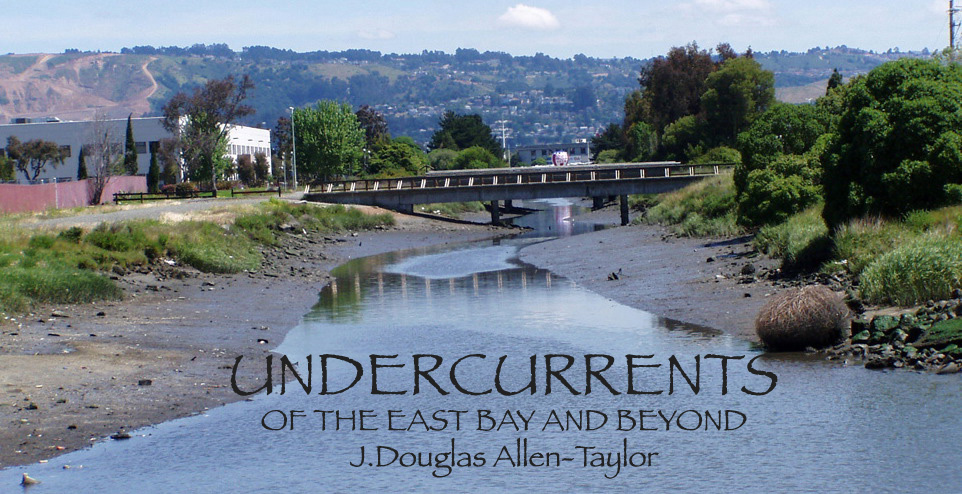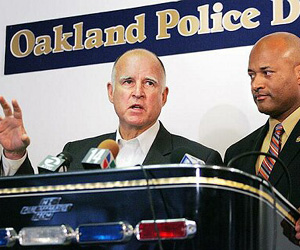

THE ONE HUNDRED MOST UNWANTED
 In their 1948 American classic book about growing
up in Oakland in the early part of the last century, Frank Gilbreth Jr. and Ernestine
Gilbreth Carey wrote in “Cheaper By The Dozen” that their father once discovered
one of the more fascinating elements of the human mind—people ccould pass by a black
typewriter every day without stopping or even thinking about it, but a typewriter
painted white simply could not be resisted. “For some reason, anyone who sees a white
typewriter wants to type on it,” Frank Gilbreth told his children on the day he brought
one home and set it on the dining room table. “Don’t ask me why. It’s psychology.”
(For those born in the 80’s and beyond and so didn’t live in those times, typewriters—which
preceded computers as the thing on which we did our writing—used to come in one color,
black. Same with telephones.)
In their 1948 American classic book about growing
up in Oakland in the early part of the last century, Frank Gilbreth Jr. and Ernestine
Gilbreth Carey wrote in “Cheaper By The Dozen” that their father once discovered
one of the more fascinating elements of the human mind—people ccould pass by a black
typewriter every day without stopping or even thinking about it, but a typewriter
painted white simply could not be resisted. “For some reason, anyone who sees a white
typewriter wants to type on it,” Frank Gilbreth told his children on the day he brought
one home and set it on the dining room table. “Don’t ask me why. It’s psychology.”
(For those born in the 80’s and beyond and so didn’t live in those times, typewriters—which
preceded computers as the thing on which we did our writing—used to come in one color,
black. Same with telephones.)
While Jerry Brown may not know how to solve Oakland’s problems—or, at this point
on his way out the door, even really care whether he does or not—the mayor certainly
knows something about human psychology. Aside from white typewriters, humans seem
to attach great, mystical value to numbers that end in zero, giving weight to programs
that are named with such numbers far out of proportion to their actual demonstrated
worth.
And so Mr. Brown gave us most famously his 10K downtown development initiative, a
campaign slogan that always appeared absent-mindedly in search of a policy to justify
the importance the mayor wanted it to convey. Who knows what benefits 10,000 new
residents were actually supposed to bring to Oakland? 10K had such a nice, authoritative
ring to it, like it knew what it was doing, even if we didn’t.
 Now, in response to this year’s horrific violent crime wave
in Oakland, Mr. Brown has fallen back on the familiar and well-tested formula, rolling
out the anti-crime “Operation Ceasfire” that will target the top 100 offenders who
Mr. Brown feels are causing a significant portion of the violent crime in the city.
Now, in response to this year’s horrific violent crime wave
in Oakland, Mr. Brown has fallen back on the familiar and well-tested formula, rolling
out the anti-crime “Operation Ceasfire” that will target the top 100 offenders who
Mr. Brown feels are causing a significant portion of the violent crime in the city.
“Every cop in Oakland will know who these guys are," the Oakland Tribune
quoted Mr. Brown as saying at the press conference announcing the new program. "These
are the people who have been wreaking havoc on our neighborhoods."
The one hundred figure is not just a rounded off approximation, but an actual list.
Oakland police officials said at the press conference that they have already prepared
the list of 100, with Bay City News (BCN) reporting that it is made up of “people
who've already been convicted of various charges as well as others who are suspected
of committing crimes but haven't yet been charged.”
According to BCN, Deputy Police Chief Howard Jordan, the Operation Ceasefire coordinator,
says that police will attempt to meet with the people on the 100 top offenders list
to convince them to give up their lives of crime, and that "those who choose
the criminal path will be subject to swift and severe punishment."
One presumes that the people on the list of 100 who are suspected of crimes but not
yet been charged, have not been charged because there is only that suspicion, and
not enough probably cause to justify an arrest or proof beyond a reasonable doubt
to secure a conviction. If that’s not true, then why haven’t they been arrested and
charged, yet? And if there isn’t enough evidence against some of these individuals
to bring charges in court, how, exactly, does the police department intend to enact
its “punishments” as promised in Mr. Brown’s “Operation Ceasfire” program? (There
were ways that used to be done in the old days, but the police department is supposed
to be out of that business now, especially with Judge Thelton Henderson monitoring
their actions.)
Meanwhile, one interesting part of the “100 Most Unwanted Oaklanders” list was pointed
out by San Francisco Chronicle columnist Chip Johnson, who wrote this week
that “by the time Oakland officials introduced on Thursday "Operation Ceasefire,
" … it was already out of date. … [The list of] 100 of the city's worst criminal
suspects… has already been reduced to 98. One of the people on the list was in the
morgue by the time the plan was announced. The other was in custody.”
This raises questions. Will two more names be added to the list to bring it back
up to 100, so that the police department will always have a list of the “100 Most
Unwanted” to be tracked down, tied up, or run off? Or will the numbers on the list
gradually be whittled down to nothing, so that we know that the worst bad-asses are
finally off our streets, and it’s safe to go outside again? That leads us to the
further puzzlement: was the list padded with people who the police don’t think are
so dangerous, or were some really dangerous people left off, just so the list could
either make, or be kept at, the politically magic number of 100?
And that leads us to another question, maybe the most important of the bunch. What
makes “Operation Ceasefire” different from all of the other anti-crime measures that
have been launched during the tenure of Jerry Brown in Oakland, and what are the
mayor and the police department offering to show us that this new operation will
be more successful than all of the anti-crime and anti-violence operations that preceded
it? In fact, what happened to the other anti-crime/anti-violence operations? Are
they still operating? Were they tossed out? What were the results, and what lessons
were learned from their implementation, or lack of implementation? Any serious new
effort to combat a problem, after all, ought to begin with an analysis and understanding
of the previous efforts.
In their article on “Operation Ceasfire,” San Francisco Chronicle political
columnists Matier & Ross said that Mr. Brown had initiated 11 “crime-busting
attacks” since taking office in 1999. Some of them went by so swiftly, they didn’t
seem to last long enough to be given names.
The one I remember most vividly is Operation Impact, launched in September of 2003
in the midst of an earlier wave of Oakland homicides. Writing in February of 2004,
Harry Harris of the Oakland Tribune wrote that in “the project—which targets
East Oakland—…[California Highway Patrol Officers] saturate main thoroughfares, including
Bancroft Avenue and International, MacArthur and Foothill boulevards. The CHP presence
allows police to direct more efforts at known hot spots for violence and drugs.”
Mr. Harris called Operation Impact a “success,” noting that during the first four
months of the operation, “serious crime like homicide, robbery and assault were down
6 percent from the same period in 2002.” Mr. Harris reported City Council Public
Safety Chair Larry Reid as saying when the CHP officers were around, "things
are peaceful. I want them here every day."
As you know if you’ve been driving the nighttime streets in East Oakland since Operation
Impact began, its focus was far different from that proposed in Operation Ceasefire.
While Ceasefire targets the one hundred people who Mr. Brown says “have been wreaking
havoc on our neighborhoods," Impact targeted the entire neighborhood, with Oakland
police, CHP, and sometimes Alameda County sheriff’s deputies and park police conducting
rolling traffic sweeps of major East Oakland throughways, stopping people at random,
giving out tickets at will. During the first four months of its operation, Mr. Harris
reported in early 2004, “the CHP arrested almost 600 people for various crimes, issued
1,564 traffic citations, towed 908 vehicles and seized six guns and 12 stolen cars.”
When the homicide rate began to slow toward the end of 2004, however, Operation Impact
did not end, the emphasis merely switching over to sideshow abatement. Eventually,
that morphed into the Oakland police department’s present policy of “sideshow zones,”
broad pockets of streets and neighborhoods from the San Leandro border to High Street
in East Oakland where sideshows do not necessarily have to be taking place, but where
police enforce stricter traffic rules than they do in the rest of the city, supposedly
with the idea that people will see the police patrols and decide not to start a sideshow.
Did Operation Impact succeed as glowingly as police and city officials were reporting
in early 2004? Did its emphasis change because the murder rate went down, and should
the city be returning to its “targeting the entire neighborhood” approach that it
said was working so well? And if if worked, why is the city launching a new project
with a completely different emphasis and approach? Or did Operation Impact not work,
and should all of its manifestations—including the “sideshow zone law” now being
enacted in East Oakland—be shut down in favor of this new approach?
Serious questions, friends. How about some answers.